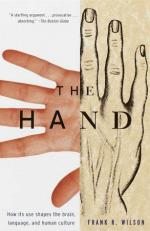
|
| Name: _________________________ | Period: ___________________ |
This quiz consists of 5 multiple choice and 5 short answer questions through Touch, Tender and Tenacious.
Multiple Choice Questions
1. In what way does Yves Guiard propose both hands perform?
(a) Precisely.
(b) In opposition.
(c) Spontaneously.
(d) In partnership.
2. What is sometimes attributed to intelligence or gender?
(a) Good penmanship.
(b) The uses to which one puts the hand.
(c) Coordination.
(d) Which hand one uses as the dominent hand.
3. What is the other main reason the author writes this book on the hand?
(a) His work as a orthopedic doctor.
(b) His work as an art teacher.
(c) His work as a neurologist.
(d) His work as a painter.
4. How does Greenfield say she knows how a child will solve Greenfield's stick puzzle?
(a) By observing which thumb is larger.
(b) By observing which foot the child starts out on when walking.
(c) By knowing the child's age.
(d) By knowing if the child can read.
5. What sport does David participate in during High School?
(a) Wrestling.
(b) Soccer.
(c) Basketball.
(d) Tennis.
Short Answer Questions
1. What is a polylith?
2. What is ChomTur?
3. What rule does Greenfield propose?
4. What is one level of communicative movement?
5. Where in Europe does Wilson take his interest in the performance problems of musicians?
|
This section contains 282 words (approx. 1 page at 300 words per page) |

|




